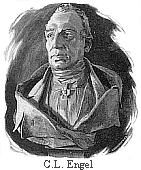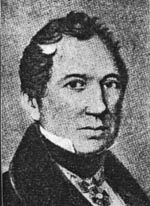 Carl
Ludvig Engel (1778-1840), who had received his diploma in architecture from
the Berlin Bauakademie in 1804, found no work in Prussia during the Napoleonic
Wars. He applied for and received an appointment as city architect in Tallinn
(Estonia). Soon he visited Finland and was asked to design an observatory for
the Academy in Turku. Ehrenström first met the talented young architect in
1814 and was immediately convinced that he had found the right man. After
spending a couple of years in St. Petersburg Engel considered moving back to
Berlin, but he was appointed architect of the reconstruction committee for
Helsinki in 1816 and remained in Finland for the rest of his life. Engel was
thrilled by his new task: "Few architects have the good fortune to plan an
entire city", he explained in a letter to a friend. And Engel had every
right to express himself in this way; within a quarter of a century he had
designed and completed about 30 public buildings in Helsinki, all in his chosen
Neo-Classical (Empire) style. Some of the buildings have been demolished, but
his most important creations around the Senate Square are preserved.
Carl
Ludvig Engel (1778-1840), who had received his diploma in architecture from
the Berlin Bauakademie in 1804, found no work in Prussia during the Napoleonic
Wars. He applied for and received an appointment as city architect in Tallinn
(Estonia). Soon he visited Finland and was asked to design an observatory for
the Academy in Turku. Ehrenström first met the talented young architect in
1814 and was immediately convinced that he had found the right man. After
spending a couple of years in St. Petersburg Engel considered moving back to
Berlin, but he was appointed architect of the reconstruction committee for
Helsinki in 1816 and remained in Finland for the rest of his life. Engel was
thrilled by his new task: "Few architects have the good fortune to plan an
entire city", he explained in a letter to a friend. And Engel had every
right to express himself in this way; within a quarter of a century he had
designed and completed about 30 public buildings in Helsinki, all in his chosen
Neo-Classical (Empire) style. Some of the buildings have been demolished, but
his most important creations around the Senate Square are preserved.
¡@
¡@
C.
L. ENGEL
 Though
born in Berlin, architect Johan Carl Ludvig Engel's (1778-1840) life's mission
was to give shape to the new Helsinki. Since 1809 Engel had been working as the
town architect of Tallinn.
He had also spent a year in St.
Petersburg studying Russian classical architecture.He
was nominated as the chief architect of the committee to rebuild Helsinki in
1816. The job was tremendous. In the next 25 years nearly 30 public buildings
designed by Engel were built in Helsinki. In addition to this, he designed
several private homes as well as buildings outside of Helsinki.Engel's
monumental neoclassical style is called Empire. Engel's most important work, the
Senate Square
represents Empire style at its best.Engel started working on the Senate Square
in 1816-19 by turning the Old Town Hall to an official residence for the
Governor General (Aleksanterinkatu 20). The second work to be completed was the
first part of the Senate Building on the east side of the square in 1822. As a
symmetrical pair for the Senate Building, Engel designed the University.
It was completed in 1832.
Though
born in Berlin, architect Johan Carl Ludvig Engel's (1778-1840) life's mission
was to give shape to the new Helsinki. Since 1809 Engel had been working as the
town architect of Tallinn.
He had also spent a year in St.
Petersburg studying Russian classical architecture.He
was nominated as the chief architect of the committee to rebuild Helsinki in
1816. The job was tremendous. In the next 25 years nearly 30 public buildings
designed by Engel were built in Helsinki. In addition to this, he designed
several private homes as well as buildings outside of Helsinki.Engel's
monumental neoclassical style is called Empire. Engel's most important work, the
Senate Square
represents Empire style at its best.Engel started working on the Senate Square
in 1816-19 by turning the Old Town Hall to an official residence for the
Governor General (Aleksanterinkatu 20). The second work to be completed was the
first part of the Senate Building on the east side of the square in 1822. As a
symmetrical pair for the Senate Building, Engel designed the University.
It was completed in 1832.
[back]
¡@
 Carl
Ludvig Engel (1778-1840), who had received his diploma in architecture from
the Berlin Bauakademie in 1804, found no work in Prussia during the Napoleonic
Wars. He applied for and received an appointment as city architect in Tallinn
(Estonia). Soon he visited Finland and was asked to design an observatory for
the Academy in Turku. Ehrenström first met the talented young architect in
1814 and was immediately convinced that he had found the right man. After
spending a couple of years in St. Petersburg Engel considered moving back to
Berlin, but he was appointed architect of the reconstruction committee for
Helsinki in 1816 and remained in Finland for the rest of his life. Engel was
thrilled by his new task: "Few architects have the good fortune to plan an
entire city", he explained in a letter to a friend. And Engel had every
right to express himself in this way; within a quarter of a century he had
designed and completed about 30 public buildings in Helsinki, all in his chosen
Neo-Classical (Empire) style. Some of the buildings have been demolished, but
his most important creations around the Senate Square are preserved.
Carl
Ludvig Engel (1778-1840), who had received his diploma in architecture from
the Berlin Bauakademie in 1804, found no work in Prussia during the Napoleonic
Wars. He applied for and received an appointment as city architect in Tallinn
(Estonia). Soon he visited Finland and was asked to design an observatory for
the Academy in Turku. Ehrenström first met the talented young architect in
1814 and was immediately convinced that he had found the right man. After
spending a couple of years in St. Petersburg Engel considered moving back to
Berlin, but he was appointed architect of the reconstruction committee for
Helsinki in 1816 and remained in Finland for the rest of his life. Engel was
thrilled by his new task: "Few architects have the good fortune to plan an
entire city", he explained in a letter to a friend. And Engel had every
right to express himself in this way; within a quarter of a century he had
designed and completed about 30 public buildings in Helsinki, all in his chosen
Neo-Classical (Empire) style. Some of the buildings have been demolished, but
his most important creations around the Senate Square are preserved.